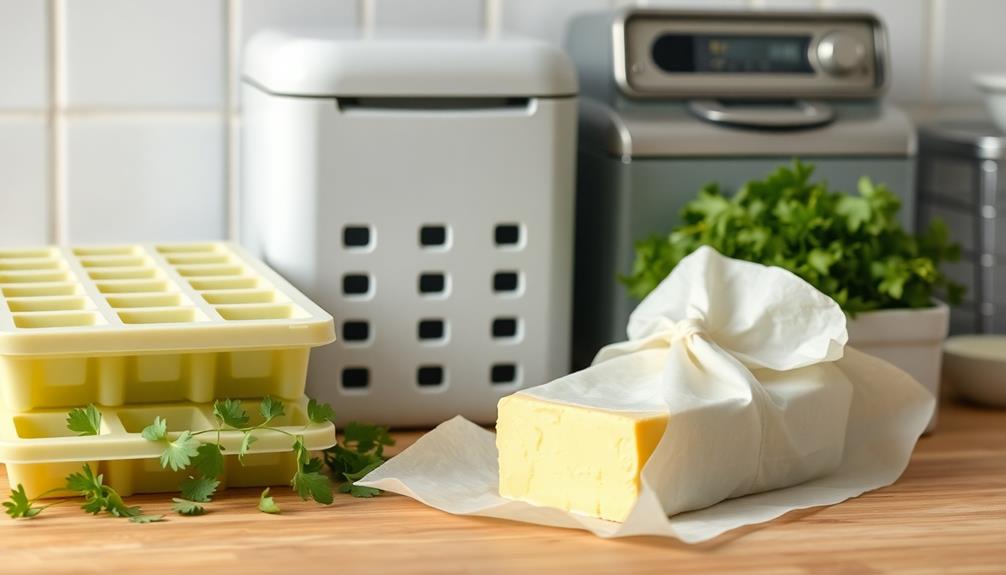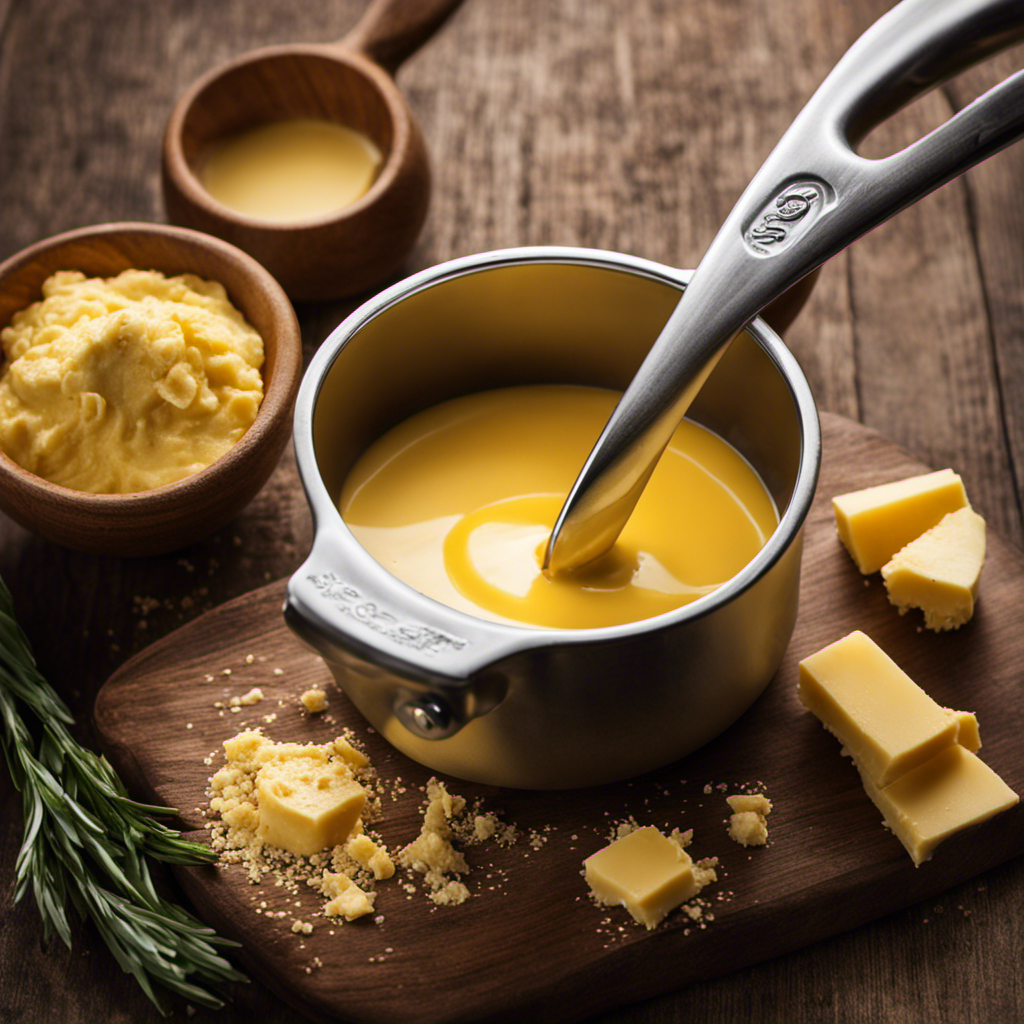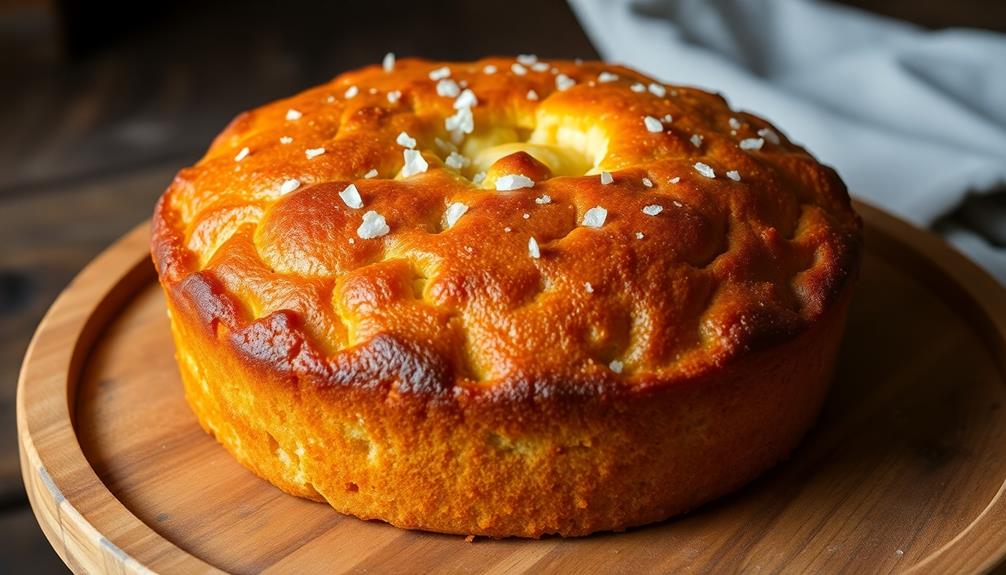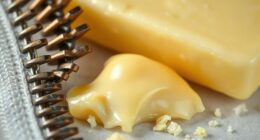To keep butter spreadable, you can use the hot water jar method by placing a clean, heatproof jar of butter into warm water. This gentle heat softens the butter evenly, making it easy to spread without melting it completely. Make certain the water isn’t too hot or cold for perfect results. If you want to master this simple technique and discover helpful tips, there’s more to explore below.
Key Takeaways
- The hot water jar method softens butter evenly by transferring gentle heat, keeping it spreadable without melting.
- Use a clean, heatproof jar with a tight lid, filled with hot water covering its sides for optimal heat transfer.
- Adjust water temperature: warmer water softens butter more, cooler water keeps it firmer; maintain steady temperature for consistency.
- Handle hot water carefully with oven mitts or towels, and tilt the jar gently to soften butter evenly.
- This technique can also soften cream cheese, melt chocolate gradually, or warm honey and dips for easier use.
Understanding Why Butter Becomes Hard
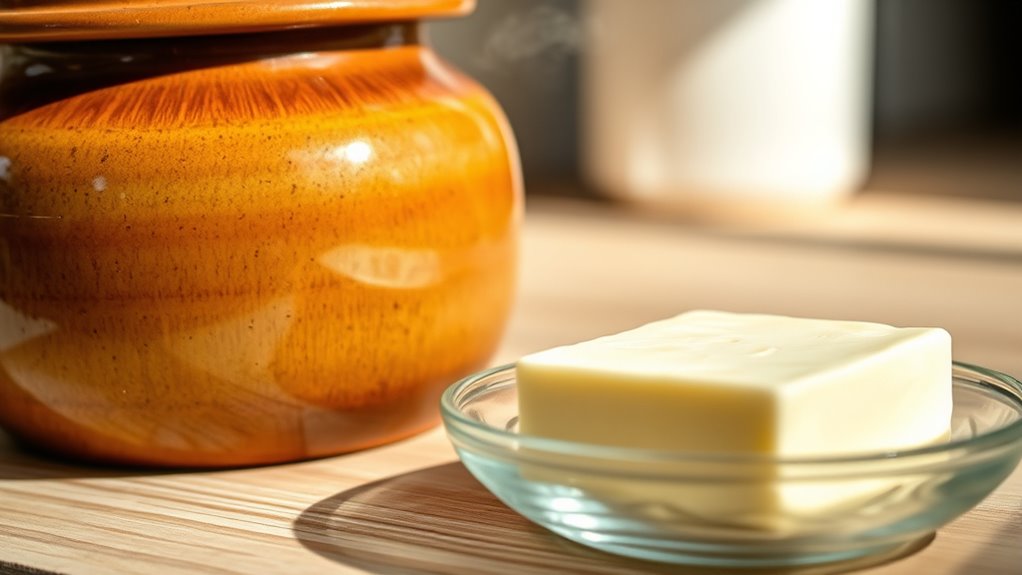
Butter becomes hard mainly because it solidifies as it cools below its melting point, which varies depending on the type and temperature. Proper butter storage is essential for dairy preservation, preventing spoilage and maintaining freshness. When stored at cooler temperatures, the fat molecules in butter crystallize, causing it to become firm and difficult to spread. This natural process is a result of the fat’s response to temperature changes, not spoilage. Understanding this helps you manage butter better—keeping it at the right temperature ensures it stays soft enough for spreading. Cold storage, while great for dairy preservation, can make butter harder than you’d like. Knowing why butter hardens allows you to adjust storage methods or use techniques like warming to keep it spreadable without compromising quality. Additionally, employing data-driven strategies can help you find optimal storage solutions tailored to your environment.
The Science Behind the Hot Water Jar Technique

The hot water jar method works because heat transfers from the warm water to the butter, softening it quickly. This efficient heat transfer helps maintain a consistent temperature, making spreadable butter easier to use. By understanding these principles, you can keep your butter at the perfect spreadable consistency longer. Additionally, using durable materials suited for kitchen use ensures the method remains safe and effective over time.
Heat Transfer Principles
Understanding the heat transfer principles behind the hot water jar method reveals why it effectively softens butter. When you place the jar in hot water, heat moves from the water to the jar’s surface through thermal conductivity. This process ensures gradual heat dissipation into the butter, preventing rapid melting. The key is controlled heat transfer, which warms the butter evenly without breaking down fats. To better grasp this, consider the table below:
| Material | Thermal Conductivity | Heat Dissipation Rate |
|---|---|---|
| Hot Water | High | Fast |
| Glass Jar | Moderate | Moderate |
| Butter | Low | Slow |
| Surrounding Air | Very Low | Very Slow |
| Overall Effect | Efficient Heat Transfer | Gentle Softening |
This balance allows butter to soften uniformly, maintaining its spreadability. Additionally, understanding heat transfer principles can help optimize various kitchen techniques beyond this method.
Temperature Stability Benefits
Maintaining a consistent temperature is key to ensuring your butter softens evenly without melting or becoming too warm. The hot water jar method helps stabilize temperature, preventing sudden changes that can affect butter’s flavor. When butter stays at a steady, moderate warmth, it remains spreadable without losing its richness or developing an off taste. Using proper storage containers alongside this technique further enhances stability, shielding butter from temperature fluctuations and external influences. This consistent environment not only preserves butter’s flavor but also maintains its texture, making it easier to spread and use. Additionally, filter replacement plays a crucial role in maintaining optimal conditions by preventing the buildup of impurities that could affect butter quality. By controlling temperature more effectively, you reduce spoilage risks and keep your butter fresh longer, ensuring every slice delivers ideal flavor and quality.
Gathering Materials and Preparing Your Jar

Before you start, gather all the necessary materials to guarantee a smooth process. First, choose a clean, heatproof jar suitable for butter storage—preferably one with a tight-fitting lid to prevent spills. Select a jar size that comfortably fits your butter block, allowing room for the hot water method. Make sure the jar is free of cracks or chips to withstand temperature changes. You’ll also need fresh, hot water to fill the jar, so have a kettle or pot ready. Additionally, keep a clean towel nearby for drying the jar after washing. Preparing your jar properly assures safety and effectiveness, making the hot water jar method easier and more successful. Keep in mind that using air purifiers can improve indoor air quality during your kitchen activities, ensuring a healthier environment. Now, you’re ready to proceed with the next step in keeping your butter consistently spreadable.
Step-by-Step Instructions for the Method
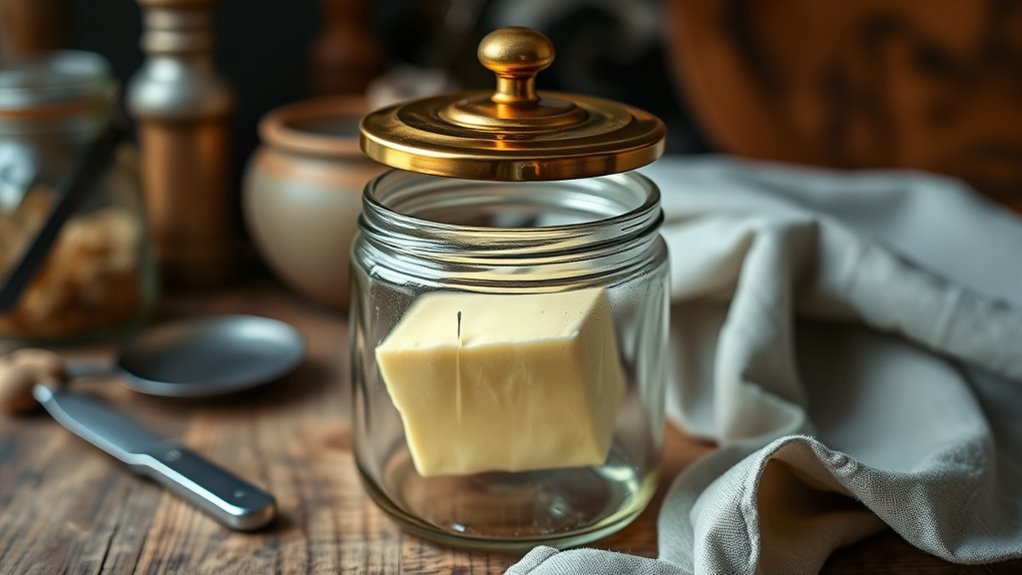
Start by preparing hot water to create a warm environment for your butter. Next, soften the butter so it can easily absorb the heat without melting completely. Once ready, you can proceed with the specific steps to keep your butter spreadable using this method. To ensure optimal results, consider the temperature control of your setup to prevent melting or uneven softening.
Subheading 1: Prepare the Hot Water
To prepare the hot water, fill a kettle or large saucepan with enough water to fully submerge the jar you plan to use. Make sure the water level is sufficient so the jar’s sides are covered when placed inside. This step is essential for maintaining proper butter storage, as it prevents the butter from becoming too firm and hard to spread. While handling hot water, prioritize kitchen safety by avoiding overfilling the container and handling it carefully to prevent spills or burns. Use oven mitts or a towel when lifting the hot vessel. Ensure your workspace is clear, and keep children or pets away. Properly prepared hot water guarantees a safe, effective method to keep your butter spreadable without compromising safety. Additionally, temperature control is key to preventing butter from melting or becoming too soft.
Subheading 2: Soften the Butter
Once you’ve prepared the hot water, carefully remove the jar from the water bath using oven mitts or a towel. To soften the butter, follow these steps for perfect spreadability:
- Gently tilt the jar to allow the softened butter to flow to the opening, ensuring even consistency.
- Use a butter knife or spreader to test the butter’s texture, aiming for a smooth, creamy butter consistency.
- If needed, re-submerge the jar briefly in hot water to further soften, but avoid melting it completely. Regularly assessing and adjusting the temperature can help prevent over-softening and maintain optimal organization of your butter.
Tips for Maintaining Perfectly Soft Butter

Maintaining perfectly soft butter can be simple if you use the right techniques. Start with proper butter storage; keep butter in a consistent, cool environment to prevent hardening or spoilage. Using airtight containers helps maintain moisture and prevents odors from affecting the butter’s softness. When you need to keep butter spreadable longer, try the hot water jar method alongside your regular kitchen techniques. Place the jar near your butter, and it will gently keep the butter at the ideal spreading temperature. Avoid frequent temperature fluctuations, which can cause butter to become too hard or too soft. Proper paint sprayer maintenance and cleaning also ensure your equipment stays in optimal condition, preventing issues that could affect the consistency of your butter. By maintaining a stable environment and employing simple kitchen techniques, you’ll always have soft, easy-to-spread butter ready for your next meal or snack.
Troubleshooting Common Issues
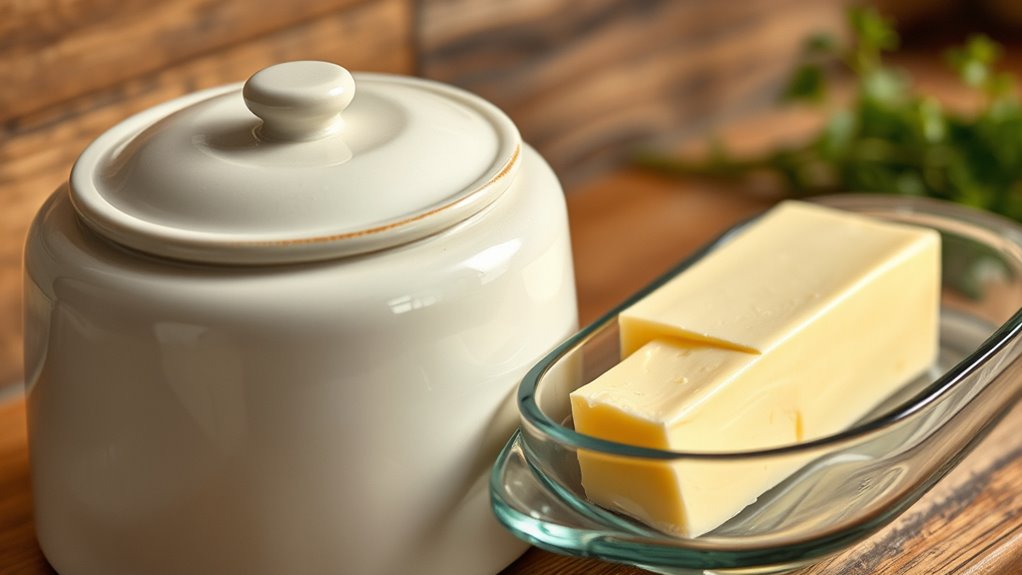
Even with the hot water jar method, you might encounter issues like butter becoming too soft or hard unexpectedly. To troubleshoot, consider these common problems:
- Butter is too soft: Check the water temperature; it may be too warm. Keep the water slightly cooler to maintain the right butter consistency without melting it.
- Butter is too hard: The water might be too cold, preventing proper temperature control. Slightly warm the water to soften the butter without making it runny.
- Inconsistent texture: If butter varies in firmness, ensure your jar is sealed tightly and the water temperature remains steady. Consistent temperature control helps maintain smooth, spreadable butter.
- Proper beneficiary designation is essential to avoid unexpected issues with your butter’s consistency and to keep your plans on track, similar to how accurate IRA beneficiary designations prevent tax complications.
Adjusting water temperature and sealing the jar properly are key to resolving these issues.
Additional Uses for the Hot Water Jar Technique

The hot water jar technique isn’t just for butter; you can also use it to gently warm other soft or delicate foods. This method offers alternative uses and is a clever kitchen hack to prevent overcooking or ruining fragile textures. For example, you can soften cream cheese for spreading or melt chocolate gradually without risking burning. It’s also useful for warming honey or syrup, making them easier to pour. Additionally, you can keep dips or spreads at a perfect serving temperature during gatherings. By using a hot water jar, you avoid direct heat, preserving flavors and consistency. This simple technique is versatile and saves time, making it a valuable tool in your kitchen arsenal for handling delicate foods effortlessly.
Frequently Asked Questions
Can I Reuse the Hot Water Jar Method for Other Spreads?
You can definitely reuse the hot water jar method for other spreads, as long as you maintain a spreadable consistency. Just make certain the jar is thoroughly cleaned and free from residue before reuse. Keep in mind, jar reusability depends on the material and condition of the jar. This method works well for maintaining spreads like butter, cream cheese, or soft cheeses, making them easier to spread without melting or becoming too firm.
How Long Does the Softened Butter Stay Spreadable Using This Method?
You might think butter’s spreadability lasts forever, but unfortunately, it’s a fleeting gift. Using this hot water jar method, your butter stays soft and spreadable for about 30 minutes to an hour—if you’re lucky. After that, it begins to firm up again, testing your patience and butter longevity skills. So, enjoy that perfect spread while it lasts, because after a while, you’ll need to rewarm it.
Is This Technique Safe for All Types of Butter?
You’re wondering if this technique is safe for all types of butter. Generally, it’s safe, but safety considerations depend on your butter’s composition. For example, flavored or processed butters may contain additives that react differently to heat. Always use lukewarm water and avoid direct contact with boiling water to prevent melting or altering the butter’s consistency. If unsure, check the butter label for any specific safety instructions.
Can This Method Be Used With Vegan or Plant-Based Butters?
Ever wondered if you can apply this trick to vegan or plant-based butters? The answer is yes, but with a twist. Many vegan alternatives and plant-based options are softer or more processed, so the hot water jar method might work differently. You’ll want to test a small amount first, as some may melt or become too runny. With a little care, you can keep your plant-based spreads just as spreadable.
Does the Temperature of the Water Affect the Butter’S Softness?
The water temperature directly affects the butter’s softness; warmer water makes the butter more spreadable, while colder water keeps it firmer. If you want a softer butter consistency, use hot water, but if you prefer it firmer, opt for cooler water. Adjust the water temperature based on how soft you want your butter to be, ensuring it’s easy to spread without melting completely.
Conclusion
Think of your butter as a frozen lake, icy and stubborn. The hot water jar acts like a gentle sunrise, slowly thawing the ice and inviting it to flow effortlessly. With this simple technique, you’re guiding your butter back to its soft, spreadable state—like dawn breaking the cold night. Just as sunrise restores warmth and ease, this method brings your butter back to life, ready to spread joy on your bread.



